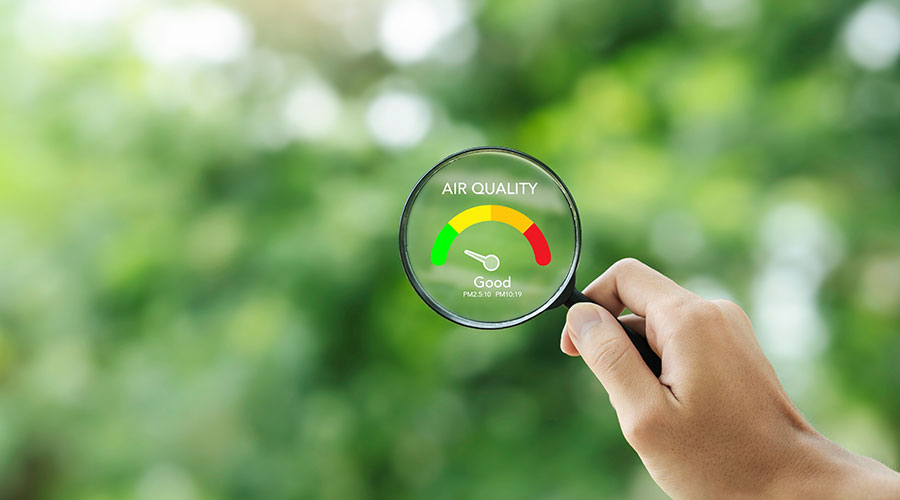Facility Occupants Can Breathe Easier When Facility Managers Have Good Data
It's probably a safe assumption that no CEO or school superintendent has ever wandered into a facility manager's office to ask whether their building is in compliance with the ventilation requirements in ASHRAE Standard 62.1. More likely, any conversation about indoor air quality would entail the organization's leader demanding to know why the third floor smells funny or wondering why a grade school is on pace to shatter its 10-year high for sick days.
When there are questions like these, what sort of data can you provide to answer them? The effects of poor IAQ may be obvious, but the causes often are not. So how do you assess and measure IAQ from a data standpoint?
Simply put, measuring, monitoring and benchmarking IAQ is hardly a straightforward proposition — at least compared with other common facility metrics, like energy use. Measuring indoor air quality means amalgamating several different metrics to give a holistic IAQ picture.
"There is not just one measurement that can assess the dynamic relationship between the presence of air contaminants and the ventilation to effectively dilute and remove them," says David Bearg, president of Life Energy Associates. "Instead, assessing the healthfulness of an indoor environment is more a matter of measuring key parameters to get a more complete IAQ picture." Effective ventilation rates, contaminant levels, absolute humidity, and even occupant satisfaction are some of those parameters, and all play a role in the overarching goal of measuring indoor air quality. But as daunting as measuring IAQ may seem, it's well worth the effort, say experts.
Studies linking productivity gains, reduced absenteeism and other benefits of good indoor air quality continue to mount. As one example, a recent study published by the University of Tulsa Indoor Air Program illustrated a linear relationship between increases in ventilation rate and the percentage of students passing standardized math and reading exams.
So, in an increasingly data-driven facility management culture, facility managers want to be sure not only that they're providing the best indoor air quality, but also that they have the data to prove it. "There's no single number that says if you're above it, you're doing well," says Ian Cull, president of Indoor Sciences and technical director of the IAQ Association. So understanding the different pieces of the puzzle is fundamental to measuring IAQ effectively.
First Steps: Air Flow
"For the building owner and facility manager, the most important thing is measuring and maintaining airflow rates and exhaust," says John McFarland, director of operations, Working Buildings, Inc. Luckily, air flow is also the easiest IAQ-related metric to measure and benchmark, says McFarland, who is also the vice chair of the LEED Indoor Environmental Quality Technical Advisory Group, as well as the vice chair of the ASHRAE 62.1 committee.
ASHRAE 62.1 is generally thought of as a design standard, but facility managers can use its recommended ventilation rates to get an idea of whether the rates in their buildings are too high (and therefore not energy efficient) or too low (and therefore not conducive to good IAQ). Measuring ventilation and exhaust is simply a matter of determining the cubic feet per minute (CFM) of airflow per person and checking that against ASHRAE 62.1's standards for different occupancies and space types. Once you've established your CFM number, the important thing is to use 62.1 to determine if the current airflow rates meet the minimum requirements for the space occupancy. This advice is especially cogent if space functions have changed.
"See if the design is still relevant," says Andrew Persily, leader of the Indoor Air Quality Group at the National Institute of Standards and Technology. "Has storage space been turned into cubicle space?" If that's the case, and the ventilation rate has never been adjusted, IAQ may be far from optimal for workers in that cubicle space.
Determining whether ventilation rates are still in spec is an important first step to measuring IAQ because doing so establishes a baseline to ensure that ventilation rates stay true, setting the stage for ongoing monitoring or even demand control ventilation. "From a cost standpoint, your best bet is installing monitoring systems to measure outdoor airflow rate in real time," says McFarland. "Once you're measuring the outdoor airflow rate, you can make adjustments. And you can develop sequences to respond directly to changing conditions, like occupancy."
Complying with
ASHRAE's IAQ Standard
Again, no one will likely check whether a building is in ongoing compliance with 62.1 on an outside airflow basis, but as Persily says, if there's ever a problem, "it'll look really bad if you don't know whether you're in compliance or not." Having that data readily available, then, amounts to a risk management best practice.
Another facet of ongoing compliance with 62.1 is preventive maintenance, which can also be a key performance indicator for IAQ. If you're measuring the percentage of prescribed preventive maintenance being completed, based on the maintenance manual that ASHRAE 62.1 requires must be provided when the building is handed over, a high percentage of completed preventive maintenance bodes well for good IAQ. It means you're regularly checking filters, regularly examining dampers to make sure they're opening and closing properly, and making sure drain pans aren't full of water.
Essentially, you're continuously commissioning your systems to make sure they're behaving as they should. "Commissioning is about getting the outside air you expect, making sure filters are clean, ensuring exhaust quantities are met and pressure relationships are correct," says Roger Hedrick, senior energy analyst at AEC and chair of the ASHRAE 62.1 committee.
ASHRAE 62.1 also provides a standard for relative humidity (maximum of 65 percent in the 2007 edition), which is another part of the IAQ whole. "Extremes of moisture, either too dry or too humid, can adversely impact IAQ," Bearg says. If the air is too wet, mold can form — an obvious negative to IAQ. But air that is too dry (especially in the winter) can be just as detrimental for IAQ. Dry air causes mucous membranes to dry out and makes occupants uncomfortable, says Bearg. So measuring the dew point temperature and humidity, and benchmarking that data, is one of the more important, yet overlooked, parts of getting a holistic IAQ view.
"Moisture control is a really important part of IAQ," says Persily. "Poor moisture control is the source of a lot of IAQ problems."
Related Topics:












